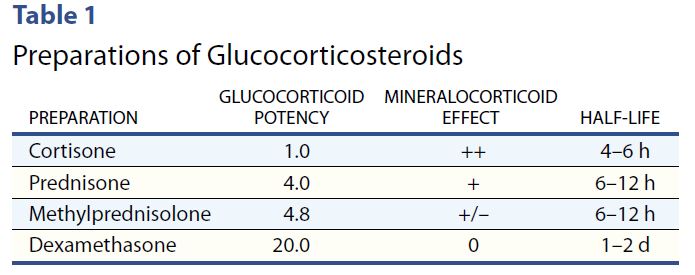CDCES – Practice Hours Requirement Changed due to Pandemic
This blog highlights important changes in required practice hours experience, celebrates 35 years of the CDCES Credential, and provides helpful study resources.
Taking the CDCES Exam in 2021 or 2022? The Certification Board for Diabetes Care and Education (CBDCE) has announced some important adjustments to the Professional Practice Experience Requirements due to the COVID pandemic.
To address the impact of the COVID-19 pandemic on the ability of health professionals pursuing the CDCES credential to accrue practice experience in diabetes care and education (DCE), the CBDCE Board of Directors has approved temporary changes to the professional practice requirement relating to DCE for initial certification.
CBCDE View Full statement here
Practice Experience Changes take effect April 1, 2021.
1) For applications submitted through 2022, minimum Diabetes Care and Education (DCE) experience needed in prior 12 months reduced from 400 hours to 200 hours;
2) For applications submitted through 2023, minimum of 1000 hours (or 2000 hours for unique qualifications pathway) of DCE experience needed can be accrued over a longer period of time. The time frame is increased from 4 years from application date to 5 years from the application date
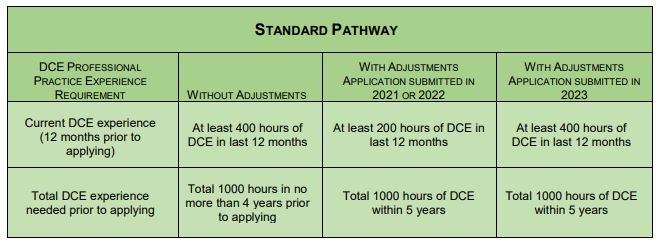
Resources to Help
Coach Beverly remembers taking her first CDCES Exam in1992 (29 years ago). Back then, applicants needed 2000 hours of practice experience to qualify and a #2 pencil to bubble in the right answers on the exam scantron. She remembers how nervous she felt as she opened her test booklet and the lack of study tools to prepare for the exam. Because of this experience, Coach Beverly wants to make sure you have the tools you need to realize your professional dream of achieving certification.
Our passion is supporting health care professionals on their journey to gain mastery and become certified diabetes specialists.
Answer 4 Questions to see what Study Tools are Right for You.
CDCES FREE Webinar and Resource Page – Join Coach Beverly on April 1 (no joking)
Practice Hours Spreadsheet Tracker. Download this sheet to easily track your practice hours.
CDCES Coach App – We send you a Question of the Week and Rationale of the Week for FREE!
10 Steps to Success – Coach Beverly has custom-designed your road map to CDCES success!
CDCES First Time Pass Rate
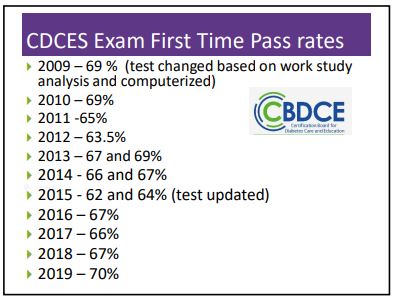
If you are taking the exam for the first time, you may be interested in a historical look back on passing rates.
As you can see, over the past ten years, about two-thirds pass the exam on their first go-round. This informs us that the test is challenging and requires a clear study plan to achieve success with special attention to those content areas that aren’t in our usual daily practice (for example, pediatrics, in-hospital, pregnancy, technology, type 1, etc.).
We offer a myriad of resources to help you on your journey (see list above).
CBDCE Celebrates 35 Years
This year, the CDCES (formerly CDE) celebrates its 35th Anniversary. There are currently over 19,500 health professionals in the diabetes care and education community that hold the CDCES credential.

And just in case you are wondering, the Certification Board for Diabetes Care and Education (CBDCE) is an independent specialty board responsible for the development and administration of the certification program for diabetes care and education programs. They are separate and independent from any other organization or association.
CBDCE’s mission is to promote comprehensive and ongoing quality diabetes clinical management, education, prevention, and support by defining, developing, maintaining, and protecting the certification and credentialing processes.
Interested in joining the CBDCE Board Of Directors?
If you already have your CDCES and are looking to get more involved with the CBDCE, they are actively seeking applicants for their Board of Directors. Find our more here!
It’s not too late to reserve your spot for our
Virtual DiabetesEd Specialist Conference | April 15-17, 2021

Whether you are new to diabetes or a seasoned expert, you’ll benefit from this virtual conference with the latest research plus critical content that you can immediately apply to your clinical practice. If you are interested in taking the CDCES or BC-ADM exam or are seeking a state-of-the-art review of current diabetes care, this course is for you.
DiabetesEd Virtual Conference Flyer 2021
Diabetes Ed Virtual 3-Day Schedule 2021
Entire Program Fee: $399
Dates: April 15-17, 2021
3 Expert Speakers
CEs: 30+ CE hours
Live Webinar Schedule: All webinars start and end times are in Pacific Standard Time
Come join our Virtual DiabetesEd Specialist Program.
Team of expert faculty includes:
- Diana Isaacs, PharmD, BCPS, BC-ADM, BCACP, CDCES – Educator of the Year, 2020
- Coach Beverly Thomassian, RN, MPH, CDCES, BC-ADM
- Ashley LaBrier, MS, RD, CDCES, Diabetes Program Coordinator
In addition to informative lectures, we also use group activities and case studies to highlight the essential knowledge, skills, and strategies needed to succeed in diabetes education today!
Prepare for CDCES or BC-ADM certification or earn hours for renewal.
Your registrations include access to all the Online Sessions plus Bonus Courses through December 31st, 2021.
This virtual program includes:
3 day live webinar courses from April 15th-17th (20 CEs) + enrollment in our Bonus Bundle (14.0+ CEs) from now through December 2021.
- Live Q & A Session with the instructor after each webinar
- Presentations by our team of experts
- Handouts and Resources for each session
- Post-test questions
- A sense of community
- If you can’t attend the live webinars, a recorded version will be posted later the same day for viewing.
View full Conference Schedule and Faculty.
Sign up for Diabetes Blog Bytes – we post one daily Blog Byte from Monday to Friday. And of course, Tuesday is our Question of the Week. It’s Informative and FREE! Sign up below!
[yikes-mailchimp form=”1″]Accreditation: Diabetes Education Services is an approved provider by the California Board of Registered Nursing, Provider 12640, and Commission on Dietetic Registration (CDR), Provider DI002. Since these programs are approved by the CDR it satisfies the CE requirements for the CDCES regardless of your profession.*
The use of DES products do not guarantee successful passage of the CDCES exam. CBDCE does not endorse any preparatory or review materials for the CDCES exam, except for those published by CBDCE.”**To satisfy the requirement for renewal of certification by continuing education for the Certification Board for Diabetes Care & Education (CBDCE), continuing education activities must be applicable to diabetes and approved by a provider on the CBDCE List of Recognized Providers (www.ncbde.org). CBDCE does not approve continuing education. Diabetes Education Services is accredited/approved by the Commission of Dietetic Registration which is on the list of CBDCE Recognized Providers.”
Preparing for the CDCES Exam FREE Webinar | April 1st
Rationale of the Week | Giving Up Tortillas?

For our March 16th Question of the Week, over 86% of respondents chose the best answer!
Before we start though, if you don’t want any spoilers and haven’t tried the question yet, you can answer below: Answer Question
Question: PZ arrives for their diabetes appointment with their food diary and glucose log book. PZ’s blood glucose levels have improved since last visit by about 20 points, with morning glucose levels in the 130 range and bedtime glucose in the 180 range. When you ask PZ about what changes they have made, PZ shrugs their shoulders and says, “I quit eating tortillas because my children said they are bad for me.”
What is the best response?
Answer Choices:
- Good for you, giving up tortillas is really hard.
- Your children sound like they are worried about your health?
- Yes, we don’t recommend tortillas since they are high in starch.
- How are you feeling about giving up tortillas?
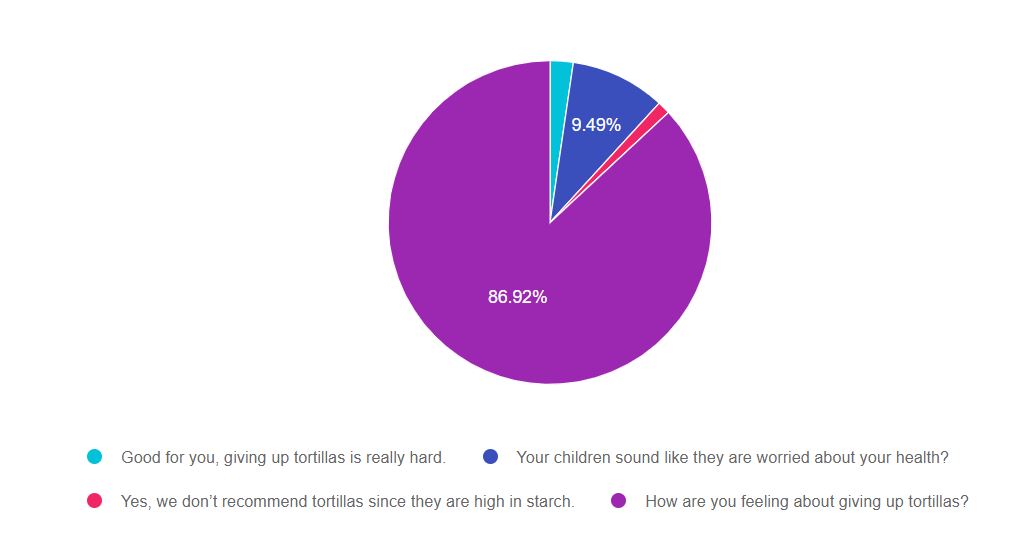
As shown above, the most common choice was option 4, the second most common answer was option 2, then option 1, and finally option 3.
Getting to the Best Answer
If you are thinking about taking the certification exam, the content of this practice test question will set you up for success. The exam will present questions that require test takers to apply a blend of science coupled with psychosocial awareness to determine the best answer.
Answers & Rationale
Answer 1 is incorrect, 2.31% chose this answer. “Good for you, giving up tortillas is really hard”. We notice that PZ shrugs their shoulders when they tell us they have given up tortillas. In addition, PZ states that they have stopped eating tortillas, not because they think it is best for them to stop, but because their children advised them that tortillas are bad. The word “bad” is loaded with judgment and perhaps PZ is feeling ashamed for eating this traditional food that has been part of their everyday life for decades. For this response, instead of affirming giving up tortillas, a better choice would be to explore this choice further.
Answer 2 is incorrect, 9.49% of you chose this answer. “Your children sound like they are worried about your health?” This seems like an accurate response, but is it the BEST response? The goal of DSME is to provide a person-centered approach. This question puts the emphasis on the children’s belief that tortillas are bad instead of exploring how the person with diabetes is responding to this drastic behavior change.
Answer 3 is incorrect, 1.28% of you chose this answer “Yes, we don’t recommend tortillas since they are high in starch.” One corn tortilla has 15gms of carbohydrate, plus fiber and other micronutrients. Tortillas can absolutely be included as part of a healthy meal plan. In addition, tortillas are more than a serving of starch, they are a central and traditional part of the meal for many cultures.
Answer 4 is correct, 86.92% of you chose this answer. ” How are you feeling about giving up tortillas?” GREAT JOB. Most of you chose this person-centered response which gives us an opportunity to see how giving up tortillas is impacting PZ from an emotional standpoint. As diabetes specialists, we know that eliminating tortillas completely may not be the best choice from an evidence-based and emotional perspective.
We hope you appreciate this week’s rationale! Thank you so much for taking the time to answer our Question of the Week and participate in this fun learning activity!
Sign up for Diabetes Blog Bytes – we post one daily Blog Byte from Monday to Friday. And of course, Tuesday is our Question of the Week. It’s Informative and FREE! Sign up below!
[yikes-mailchimp form=”1″]Accreditation: Diabetes Education Services is an approved provider by the California Board of Registered Nursing, Provider 12640, and Commission on Dietetic Registration (CDR), Provider DI002. Since these programs are approved by the CDR it satisfies the CE requirements for the CDCES regardless of your profession.*
The use of DES products does not guarantee the successful passage of the CDCES exam. CBDCE does not endorse any preparatory or review materials for the CDCES exam, except for those published by CBDCE.
Rationale of the Week | Get Your Calculator Ready!

For our March 9th Question of the Week, over 67% of respondents chose the best answer!
Before we start though, if you don’t want any spoilers and haven’t tried the question yet, you can answer below: Answer Question
Question: JR wants to lose weight in the next 30 days by drinking less juice. There are 100 calories per glass of juice and JR usually drinks 3 glasses a day.
How much weight would JR lose by only drinking 1 glass a day?
Answer Choices:
- 0.85 pounds
- It depends on the type of juice
- 1.7 pounds
- 3000 calories
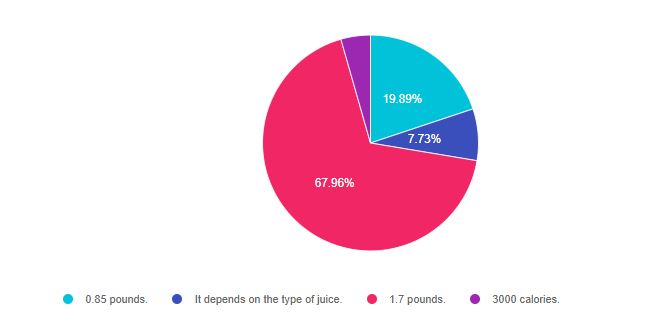
As shown above, the most common choice was option 3, the second most common answer was option 1, then option 2, and finally option 4.
Getting to the Best Answer
If you are thinking about taking the certification exam, the content of this practice test question will set you up for success. The exam will present questions that require test takers to apply their math skills to a word problem and choose the BEST answer. If you see a question that requires math, just take a deep breath, read the question carefully and call upon your abundant common sense. For this particular question, we also need to know that 1 pound equals 3,500 kcals.
Answers & Rationale
Answer 1 is incorrect, 19.89% chose this answer. “0.85 pounds”. This was the juicy answer designed to distract test takers from the best answer. JR was drinking 3 glasses of juice and is reducing their intake by 2 glasses of juice. Their net calorie reduction, therefore, is not one glass a day, but 2 glasses a day. Each glass contains 100 calories, leading to a 30-day calorie deficit of 6,000 calories a month (not 3,000 calories).
Answer 2 is incorrect, 7.73% of you chose this answer. “It depends on the type of juice”. Since we are given the caloric content of the juice, we don’t need to know what kind of juice to get the best answer.
Answer 3 is correct, 67.96% of you chose this answer “1.7 pounds”. Good job. JR was drinking 3 glasses of juice and is reducing their intake by 2 glasses of juice. Each glass contains 100 calories. This leads to a 200 calorie a day deficit, and a 30-day calorie deficit of 6,000 calories. 6,000 calories divided by 3,500 calories (1 pound) equals 1.7 pounds.
Answer 4 is incorrect, 4.42% of you chose this answer. “3,000 calories”. If you go back to the root of the question, it asks the test taker, “How much weight” would JR lose. Weight is expressed in kg or pounds, not calories. By making sure the answers’ unit of measure matches the questions’ unit of measure, test takers can eliminate wrong answers.
Special note: I want to acknowledge that weight and weight loss are complicated. It is so much more than a function of calories consumed or deprived. There are hormones, genetics, set-points, co-conditions, and a whole range of other influencing factors that contribute to weight at any given time. This sample test question does not address these factors since its main focus was providing a word problem with math calculations.
I would encourage you to check out this blog on Diabetes and Diet Culture, which interviews Megrette Fletcher, M.Ed., RD, CDCES, co-founder of The Center for Mindful Eating, co-founder of WN4DC Symposium, and author of five mindful eating books. Megrette is a trailblazer in the field and offers a new approach that values the individual first and encourages us to address our own weight biases.
We hope you appreciate this week’s rationale! Thank you so much for taking the time to answer our Question of the Week and participate in this fun learning activity!
Sign up for Diabetes Blog Bytes – we post one daily Blog Byte from Monday to Friday. And of course, Tuesday is our Question of the Week. It’s Informative and FREE! Sign up below!
[yikes-mailchimp form=”1″]Accreditation: Diabetes Education Services is an approved provider by the California Board of Registered Nursing, Provider 12640, and Commission on Dietetic Registration (CDR), Provider DI002. Since these programs are approved by the CDR it satisfies the CE requirements for the CDCES regardless of your profession.*
The use of DES products does not guarantee the successful passage of the CDCES exam. CBDCE does not endorse any preparatory or review materials for the CDCES exam, except for those published by CBDCE.
Question of the Week | How Many Insulin Pens?

JR is 24 years old and uses an insulin pen for their basal insulin injections each evening. JR takes 30 units a night and each insulin pen holds 300 units of insulin.
How many insulin pens would JR need for one month?
- 3 pens
- 4 pens
- 10 pens
- 1 box
Click here to test your knowledge!
Sign up for Diabetes Blog Bytes – we post one daily Blog Byte from Monday to Friday. And of course, Tuesday is our Question of the Week. It’s Informative and FREE! Sign up below!
[yikes-mailchimp form=”1″]Accreditation: Diabetes Education Services is an approved provider by the California Board of Registered Nursing, Provider 12640, and Commission on Dietetic Registration (CDR), Provider DI002. Since these programs are approved by the CDR it satisfies the CE requirements for the CDCES regardless of your profession.*
The use of DES products does not guarantee the successful passage of the CDCES exam. CBDCE does not endorse any preparatory or review materials for the CDCES exam, except for those published by CBDCE.
Plant-Based Eating Resources | Free Resource Friday
It’s National Nutrition Month!

We have compiled a list of plant-based therapy articles and resources to celebrate the importance of nutrition.
Sign up for Diabetes Blog Bytes – we post one daily Blog Byte from Monday to Friday. And of course, Tuesday is our Question of the Week. It’s Informative and FREE! Sign up below!
[yikes-mailchimp form=”1″]
Accreditation: Diabetes Education Services is an approved provider by the California Board of Registered Nursing, Provider 12640, and Commission on Dietetic Registration (CDR), Provider DI002. Since these programs are approved by the CDR it satisfies the CE requirements for the CDCES regardless of your profession.*
The use of DES products does not guarantee the successful passage of the CDCES exam. CBDCE does not endorse any preparatory or review materials for the CDCES exam, except for those published by CBDCE.
Steroids, Sugar Spikes and Management Strategies
JR is 64 years old, in hospital with type 2 diabetes and COVID. JR normally manages their diabetes with metformin, but during this inpatient stay, JR is on prednisone therapy which has spiked sugar levels into the 250 mg/dl to 350 range. JR is receiving bolus insulin sliding scale with meals and bedtime glargine, but blood sugars are persistently elevated. To improve outcomes for JR, it is important to keep blood glucose levels less than 180 mg/dl, but what should we recommend to get glucose to goal?
What are some strategies to get blood sugar to target while on steroids?
There is no consensus on the best approach to manage this situation. Up until this point in history, steroid-induced hyperglycemia was mostly found in people with diabetes in COPD, those undergoing chemotherapy or in post-transplant situations.

Oral Meds plus an Old Friend
With the COVID pandemic, many people with diabetes in hospitals and at home, are on steroids. Health care professionals are trying to figure out how to lower glucose levels.
For people with type 2 diabetes and COVID, the latest research indicates that sitagliptin (Januvia) not only helps maintain blood glucose but also decreases the inflammatory response associated with COVID infections. If not contraindicated, sitagliptin can be used in conjunction with insulin, to treat the extreme insulin resistance and hyperglycemia caused by steroid therapy.
To treat steroid induced hyperglycemia, we are going to call on our old insulin friend, NPH. Neutral Protamine Hagedorn (NPH) is an intermediate acting basal insulin. NPH insulin is made by mixing regular insulin and protamine in exact proportions with zinc and phenol such that a neutral-pH is maintained and crystals form.
NPH insulin’s peak action time matches steroid’s action time
NPH insulin is cloudy and has an onset of 1–4 hours. Its peak is 6–10 hours and its duration is about 10–16 hours.
Steroids have their highest potency at 4-12 hours, with the exception of the very potent dexamethasone, which has a half life of 1-2 days.
However, with all steroids, including dexamethasone, people will experience elevated glucose values after breakfast, lunch, dinner, and at bedtime but will have a significant drop toward normal glucose overnight.
Therefore, hyperglycemia is greatest 1–2 hours after a meal, with persistent elevation until the following meal, followed by a return to normal overnight.
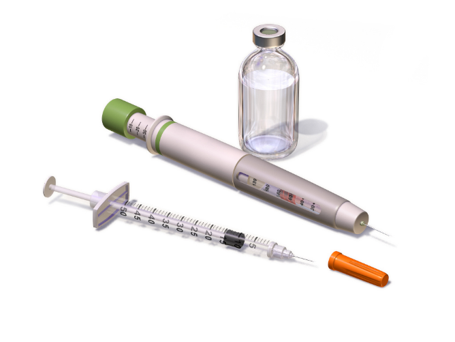
NPH Insulin Dosing Strategies
There are several articles (see below) that recommend a variety of NPH dosing strategies. Generally, insulin dosing is based on a combination of steroid dose and body weight. For those on lower dose steroid (ie less than 40 mg prednisone daily) a starting NPH insulin dose of 0.1 – 0.2 units per kg is reasonable. If JR weighs 100 kg, that means 10 to 20 units of NPH daily.
If JR is on a higher steroid dose, or blood sugars are extremely elevated, JR may need 0.3 units/kg or 30 units of NPH daily. Of course, we also need to keep nutritional status in mind as we determine best dose. People who are not eating or NPO, will require less insulin, even in the presence of steroids.
The timing of NPH administration matches the timing of the steroid therapy.
In addition, coverage for carbohydrates at meals and correction insulin bolus for hyperglycemia can help prevent post-prandial hyperglycemia.
A simple getting started strategy – 70/30 Insulin
A simple strategy I have used over many years, that I find safe and effective, is giving the basal-bolus premixed 70/30 insulin with the morning dose of steroid. A safe starting range is around 10 units in the morning and gradually increases 10-20% daily to get glucose to target. In addition, bolus coverage for carbs and hyperglycemia can be given at lunch and dinner.
Since blood sugars trend down overnight, nighttime NPH insulin is not usually needed.
Keeping it flexible
As the person starts recovering and steroid doses are gradually tapered down, it is important to also decrease the NPH insulin dose and bolus insulins to prevent hypoglycemia.
In conclusion:
Keeping blood sugars on target improves outcomes. For people with diabetes, steroids can cause a hyperglycemic crisis. Thoughtful and progressive management using NPH and bolus insulins can turn the tide and help get blood glucose levels to goal.
Join Coach Beverly at our Virtual Conference for more information on COVID and Diabetes Management Strategies.
Reference Articles
Glycemic Control in Hospitalized Patients with Diabetes Receiving Corticosteroids Using a Neutral Protamine Hagedorn Insulin Protocol: A Randomized Clinical Trial. Khowaja A, Alkhaddo JB, Rana Z, Fish L. Diabetes Ther. 2018 Aug;9(4):1647-1655.
How to Manage Steroid Diabetes in the Patient With Cancer
David S. Oyer, MD, FACE, Ajul Shah, BS, and Susan Bettenhausen, APRN, CDE, 2006
Virtual DiabetesEd Specialist Course
Earn 30+ CEs | April 15-17, 2021

Virtual DiabetesEd Specialist Program
Whether you are new to diabetes or a seasoned expert, you’ll benefit from this virtual conference with the latest research plus critical content that you can immediately apply to your clinical practice.
DiabetesEd Virtual Conference Flyer 2021
Diabetes Ed Virtual 3-Day Schedule 2021
Prepare for CDCES or BC-ADM certification or earn hours for renewal.
If you are interested in taking the CDCES or BC-ADM exam or are seeking a state of the art review of current diabetes care, this course is for you. Our team has been fine-tuning this course for over fifteen years, and we know what you need.
Can’t join live? No worries, your registration guarantees access to the recorded content through Dec 31, 2021!
Team of expert faculty includes:
- Diana Isaacs, PharmD, BCPS, BC-ADM, BCACP, CDCES – Educator of the Year, 2020
- Coach Beverly Thomassian, RN, MPH, CDCES, BC-ADM
- Ashley LaBrier, MS, RD, CDCES, Diabetes Program Coordinator
In addition to informative lectures, we also use group activities and case studies to highlight the essential knowledge, skills, and strategies needed to succeed in diabetes education today!
Your registrations include access to all the Online Sessions plus Bonus Courses through December 31st, 2021.
Question of the Week | What About Tortillas?

PZ arrives for their diabetes appointment with their food diary and glucose log book. PZ’s blood glucose levels have improved since last visit by about 20 points, with morning glucose levels in the 130 range and bedtime glucose in the 180 range. When you ask PZ about what changes they have made, PZ shrugs their shoulders and says, “I quit eating tortillas because my children said they are bad for me.”
What is the best response?
- Good for you, giving up tortillas is really hard.
- Your children sound like they are worried about your health?
- Yes, we don’t recommend tortillas since they are high in starch.
- How are you feeling about giving up tortillas?
Click here to test your knowledge!
Virtual DiabetesEd Specialist Course
Earn 30+ CEs | April 15-17, 2021

Virtual DiabetesEd Specialist Program
Whether you are new to diabetes or a seasoned expert, you’ll benefit from this virtual conference with the latest research plus critical content that you can immediately apply to your clinical practice.
DiabetesEd Virtual Conference Flyer 2021
Diabetes Ed Virtual 3-Day Schedule 2021
Prepare for CDCES or BC-ADM certification or earn hours for renewal.
If you are interested in taking the CDCES or BC-ADM exam or are seeking a state of the art review of current diabetes care, this course is for you. Our team has been fine-tuning this course for over fifteen years, and we know what you need.
Can’t join live? No worries, your registration guarantees access to the recorded content through Dec 31, 2021!
Team of expert faculty includes:
- Diana Isaacs, PharmD, BCPS, BC-ADM, BCACP, CDCES – Educator of the Year, 2020
- Coach Beverly Thomassian, RN, MPH, CDCES, BC-ADM
- Ashley LaBrier, MS, RD, CDCES, Diabetes Program Coordinator
In addition to informative lectures, we also use group activities and case studies to highlight the essential knowledge, skills, and strategies needed to succeed in diabetes education today!
Your registrations include access to all the Online Sessions plus Bonus Courses through December 31st, 2021.
Bonus Courses worth 14 + CEs FREE – When you register for our Virtual Course, you have immediate access to these Bonus DiabetesEd University Online Courses – for FREE!
Sign up for Diabetes Blog Bytes – we post one daily Blog Byte from Monday to Friday. And of course, Tuesday is our Question of the Week. It’s Informative and FREE! Sign up below!
[yikes-mailchimp form=”1″]Accreditation: Diabetes Education Services is an approved provider by the California Board of Registered Nursing, Provider 12640, and Commission on Dietetic Registration (CDR), Provider DI002. Since these programs are approved by the CDR it satisfies the CE requirements for the CDCES regardless of your profession.*
The use of DES products does not guarantee the successful passage of the CDCES exam. CBDCE does not endorse any preparatory or review materials for the CDCES exam, except for those published by CBDCE.




